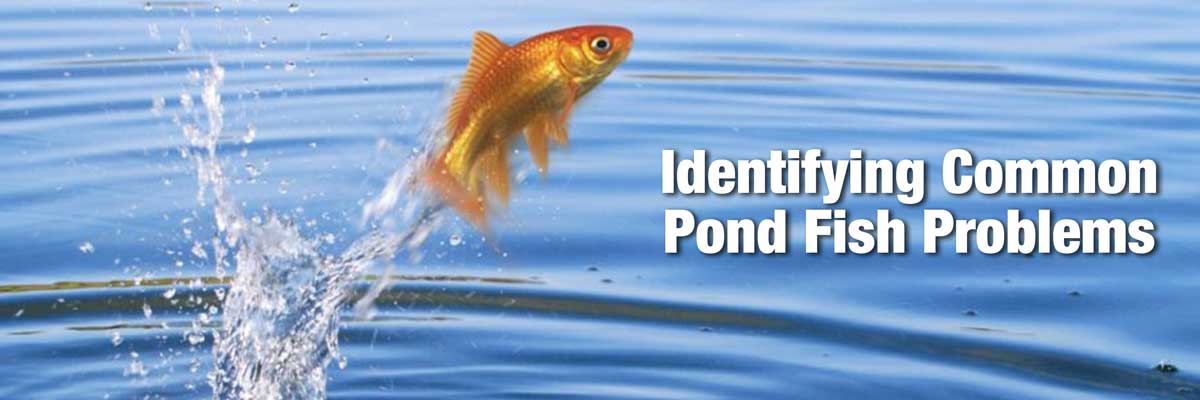Common Pond Fish Problems
Ever wonder if your fish can talk to you? Paying close attention to their behavior or noticing symptoms on their body can speak loudly as to how your fish are feeling. Use this “symptom checker” guide to help pinpoint common fish problems and what actions should be taken.

FISH BEHAVIORS
Flashing (flipping sideways to catch light)- usually indicates irritated skin. Could be parasites like flukes, anchor worm, or fish lice; possible off water chemistry
Piping (gasping for air at the water surface or under waterfall)- lack of oxygen from burned gills, poor water quality, or gill flukes
Rubbing (bumping against rocks)- usually indicates irritated skin. Could be parasites or off water chemistry; in some instances, may be spawning
Folded fins -general sign of stress from a variety of health issues.
Isolated -stress due to altered environment; temperature shifts, pH changes, chemical imbalances
Jumping- may happen during spawning, or high ammonia levels
Lethargic -ammonia poisoning, or extreme water temperature swings; lack of oxygen from high air and water temperatures during the summer.
Lying flat -ammonia poisoning; poor water quality
Tail up, Nose down -swim bladder
Nose up, Tail Down -swim bladder
Wobble while swimming- swim bladder
Belly up -swim bladder over-filled or stuck full of air
Spiral Swimming - swim bladder due to internal bacterial infection
Unable to stay sunken- swim bladder disease
SIGNS OF PROBLEM (SYMPTOMS)
Open wounds -ulcers from Aeromonas bacteria (external); poor water quality or nutrition.
Fringed tail or fins -fin rot; bacterial infection (external)
White cottony lips – “mouth fungus” actually a bacterial infection (external)
Bent Tail – could be bacterial (internal)
Emaciation -internal bacterial infection or internal parasites
White cottony film -fungus; usually a secondary infection to a previous ailment or injury
Distended abdomen- bloat from kidney failure; swollen or obstructed ducts that won’t release eggs
Extruded eyes – “pop eye” or Exophalmia -symptom of underlying conditions from physical injury, water chemistry, or organisms like bacteria, fungus, or parasites.
Protruding Scales – dropsy is a symptom of various unknown underlying causes
Red streaks -sure sign of serious water quality issues. High ammonia or nitrite can cause hemorrhaging
Dry skin- signs of high stress caused by outside sources such as predator scare, spawning, bullying, etc.
Cloudy eyes -caustic reactions to heavy metals or sudden change in water chemistry
Excessive mucus -parasitic disease, like fish lice or anchor worm, causing irritation of the skin.
White specks- Ich; a parasite easily treated with pond salt
Internal Bacterial Infections- Medicinal treatments are required; it is easier and less expensive to set up a hospital tank and treat infected fish separately than to treat the whole pond. Sometimes medicated food can be given, provided the fish is well enough to eat.
External Bacterial Infections- Melafix can be applied directly to the pond or in a hospital tank. Foaming does occur but will dissipate. Do not over dose. Be sure adequate aeration is present.
Fungus- May be treated with pond salt. Higher doses used for treatments may cause harm to aquatic plants. Removal is recommended before treatment. Pond salt testers are available.
Internal Parasites- Medicinal treatments are required. Sometimes medicated food can be given. Most parasites attack fish with low or weakened immunity. In some instances, it may be necessary to treat the entire pond, not just the infected fish.
External Parasites- some (but not all) parasites may be treated with higher doses of pond salt and then water changes. Several treatments may be required to eradicate different stages of life for the pest. Broad Spectrum Disease Treatment is available, 16 oz. treats up to 4,800 gals
Stress- Pond salt can be used as a routine maintenance to reduce stress. [Read Pond Salt Treatment: Learn the Benefits of using Salt in your Pond] Provide hiding places and adequate surface coverage on the pond with water lilies, lotus, water lettuce, and water hyacinth.
Water Quality- Testing for ammonia (which is heavier than water), pH, kH, general hardness, nitrites, and nitrates can help determine the true cause of stress. [read This is a Test…the Chemistry of Your Pond Water] Water changes may be necessary and/or filtration, plants or additives improved.
It is important to not jump to conclusions when your fish’s behavior changes or becomes erratic. Always test water quality before treating for any other diseases such as, bacterial infections or parasites. Over reacting to small changes can make them into large problems.
“The best defense is always a good offense.” Regular testing of your pond water will put you in the know before anything visually goes wrong in your pond.
One effective way to maintain the health of your pond fish and prevent common issues is by using products that promote a balanced ecosystem. TheraP, for instance, is specially formulated to promote pond fish health. This product helps in improving water quality, reducing fish stress, and enhancing the overall vitality of your aquatic pets. By incorporating TheraP into your regular pond maintenance routine, you can ensure a healthier and more vibrant pond environment for your fish.
